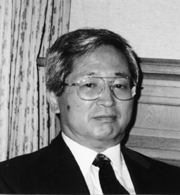
| Hidehiko Tanaka Chairperson Promotion Committee of the Project for Fundamental Information Technology of the Next Generation, Ministry of International Trade and Industry (MITI) (Graduate School Professor, University of Tokyo) |

| Hidehiko Tanaka Chairperson Promotion Committee of the Project for Fundamental Information Technology of the Next Generation, Ministry of International Trade and Industry (MITI) (Graduate School Professor, University of Tokyo) |
1. Toward the Second Half of the RWC Project
The Real World Computing (RWC) Project started in 1992, and its first half was completed in March 1997.
After a long planning session for the second half period of the RWC Project, the newly established Promotion Committee held a meeting last May to fix the master plan for the second half of the project.
The outline of this plan and my expectations regarding this project are discussed below.
The original goal of this project was to establish a new information processing technologies capable of handling ambiguous information as exists in the real world. In the first half of the project, research in the fields of novel functions, parallel systems, and optical technologies was conducted. Based on these results and world-wide technological trends, the Evaluation and Promotion Committee meeting held in March, 1996 and the subsequent Preparatory Committee meetings have examined the plan for the second half period of the Project. As a result, we have decided to concentrate our R&D activities into two fields: "Real World Intelligence Technology" and "Parallel and Distributed Computing Technology."
This means that the second half period starting in FY1997 has shifted the focus on the establishment of important elemental technologies to these two fields, by narrowing explorative and basic research of the first period of the RWC Project, while inheriting its framework, to develop fundamental information technology of the next generation.
It had been initially decided that one technology should be established by integrating these fields, but the plan was modified so that these two fields could advance freely.
2. The Objectives of the Project and R&D Activities
The project is roughly divided into two fields, each of which will serve to develop fundamental technologies closely tied to future information technologies.
Specifically, our goal within the Real World Intelligence Field is to develop fundamental technologies for realizing more advanced intelligence by incorporating learning and self-organizing functions as its basic components, and for enabling more certain and in-depth understanding by processing pattern information such as images, speech, and text in a parallel and integrated manner, thus broadening the application domain of information processing.
This technology is expected to be a core technology for overcoming the limitations of conventional intelligence technology and for allowing intelligence technology to grow sufficiently for practical use. This will be achieved by resolving the problems intrinsic to conventional information processing, including the difficulties in processing pattern information often encountered in the real world due to its diversity and ambiguity (unlike the relatively easy processing of symbols), as well as the restrictions imposed when dealing with the dynamism and variety of humans and the real world, in a fixed environment.
The goals for the Parallel and Distributed Computing Field is to set up fundamental technologies so parallel processing can solve one problem using many processors, and so distributed processing can freely exploit geographically-scattered computers by using high-speed communication networks. These goals were selected to provide future solution for faster and more varied kinds of processing.
These goals do not simply support the increasing importance of super-high-speed computers as scientific computation advances, but also support the expected daily use of multiple computers for every-day business. Currently many problems exist using multiple computers seamlessly. This problem, when solved will greatly increase the use of computers. To do this, it will require the fusion of fundamental technologies like parallel and distributed processing.
3. Research and Development System
The R&D activities in the second half of the RWC Project involve basically two R&D themes, relatively independent of each other, under the title of "the Fundamental Information Technology of the Next Generation." This allows both fields to adopt a suitable research system.
The Real World Intelligence Field is relatively research-intensive and is thus divided into detailed themes for research and development. By clearly indicating each research target, progress can be easily understood. In addition, this research field is being undertaken by a group consisting of the Electrotechnical Laboratoryıs RWI Center, Tsukuba Research Center, and the Distributed Laboratories of participating companies and institutions.
On the other hand, the Parallel and Distributed Computing Field is development-intensive with relatively clear-cut deliverables. The R&D activities are characterized by global acceptance and the advanced awareness of global standards and de-facto standard products.
This field is being undertaken by a group consisting of the Tsukuba Research Center and the Distributed Laboratories of participating companies and institutions.
These activities will be carried out through a close collaboration of several newly established committees and meetings as well as working groups. Research in these two fields is promoted by the MITI Promotion Committee, and evaluated by the MITI Evaluation Committee.
4. Expected Results
The two fields chosen for the second half period, the Real World Intelligence and the Parallel and Distributed Computing Fields, are important fundamental technology fields whose development will bring about future information processing systems.
The Real World Intelligence Field is a base for creating more advanced processing, and the Parallel and Distributed Processing Field will create the underlying foundation from which it can operate.
The remaining four and a half years of the RWC Project's second half is not very long, but should be sufficient for clearly defined targets.
Let's strive to create these fundamental future technologies through global cooperation.